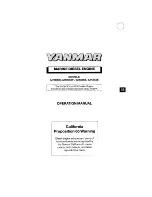
7.5
Flushing instructions
Flushing instructions in this Product Guide are for guidance only. For contracted projects, read the specific
instructions included in the installation planning instructions (IPI).
7.5.1 Piping and equipment built on the engine
Flushing of the piping and equipment built on the engine is not required and flushing oil shall not be pumped
through the engine oil system (which is flushed and clean from the factory). It is however acceptable to
circulate the flushing oil via the engine sump if this is advantageous. Cleanliness of the oil sump shall be
verified after completed flushing.
7.5.2 External oil system
Refer to the system diagram(s) in section External lubricating oil system for location/description of the
components mentioned below.
If the engine is equipped with a wet oil sump the external oil tanks, new oil tank (2T03), renovating oil tank
(2T04) and renovated oil tank (2T05) shall be verified to be clean before bunkering oil. Especially pipes
leading from the separator unit (2N01) directly to the engine shall be ensured to be clean for instance by
disconnecting from engine and blowing with compressed air.
If the engine is equipped with a dry oil sump the external oil tanks, new oil tank and the system oil tank
(2T01) shall be verified to be clean before bunkering oil.
Operate the separator unit continuously during the flushing (not less than 24 hours). Leave the separator
running also after the flushing procedure, this to ensure that any remaining contaminants are removed.
If an electric motor driven stand-by pump (2P04) is installed the pipe shall be flushed running the pump
circulating engine oil through a temporary external oil filter (recommended mesh 34 microns) into the engine
oil sump through a hose and a crankcase door. The pump shall be protected by a suction strainer (2F06).
Whenever possible the separator unit shall be in operation during the flushing to remove dirt. The separator
unit is to be left running also after the flushing procedure, this to ensure that any remaining contaminants
are removed.
7.5.3 Type of flushing oil
Viscosity
In order for the flushing oil to be able to remove dirt and transport it with the flow, ideal viscosity is 10...50
cSt. The correct viscosity can be achieved by heating engine oil to about 65°C or by using a separate
flushing oil which has an ideal viscosity in ambient temperature.
Flushing with engine oil
The ideal is to use engine oil for flushing. This requires however that the separator unit is in operation to
heat the oil. Engine oil used for flushing can be reused as engine oil provided that no debris or other con-
tamination is present in the oil at the end of flushing.
Flushing with low viscosity flushing oil
If no separator heating is available during the flushing procedure it is possible to use a low viscosity flushing
oil instead of engine oil. In such a case the low viscosity flushing oil must be disposed of after completed
flushing. Great care must be taken to drain all flushing oil from pockets and bottom of tanks so that flushing
oil remaining in the system will not compromise the viscosity of the actual engine oil.
Lubricating oil sample
To verify the cleanliness a LO sample shall be taken by the shipyard after the flushing is completed. The
properties to be analyzed are Viscosity, BN, AN, Insolubles, Fe and Particle Count.
Commissioning procedures shall in the meantime be continued without interruption unless the commissioning
engineer believes the oil is contaminated.
78
Product Guide Wärtsilä 34DF - 3/2012
Product Guide
7. Lubricating Oil System
















































